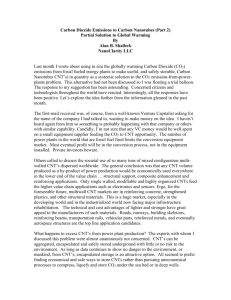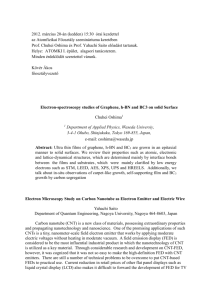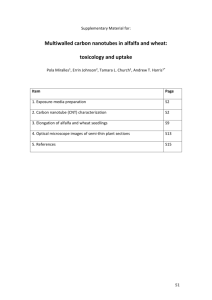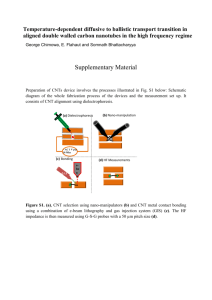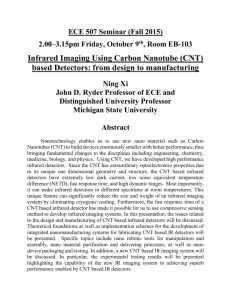P191 - World Journal of Engineering
advertisement
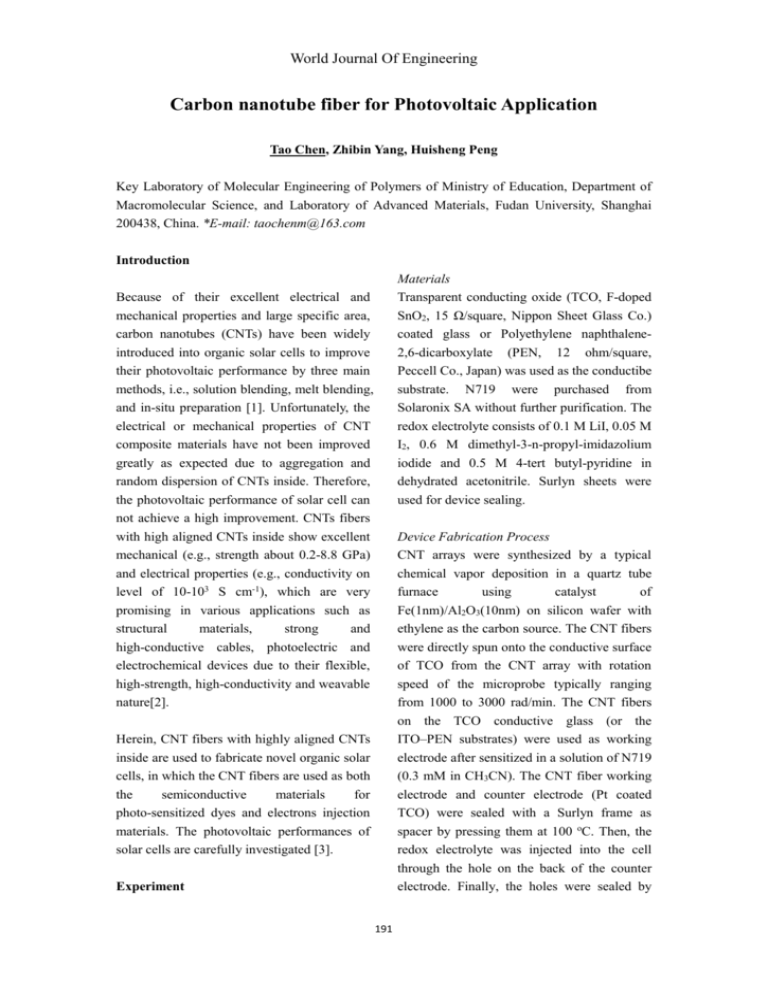
World Journal Of Engineering Carbon nanotube fiber for Photovoltaic Application Tao Chen, Zhibin Yang, Huisheng Peng Key Laboratory of Molecular Engineering of Polymers of Ministry of Education, Department of Macromolecular Science, and Laboratory of Advanced Materials, Fudan University, Shanghai 200438, China. *E-mail: taochenm@163.com Introduction Materials Transparent conducting oxide (TCO, F-doped SnO2, 15 Ω/square, Nippon Sheet Glass Co.) coated glass or Polyethylene naphthalene2,6-dicarboxylate (PEN, 12 ohm/square, Peccell Co., Japan) was used as the conductibe substrate. N719 were purchased from Solaronix SA without further purification. The redox electrolyte consists of 0.1 M LiI, 0.05 M I2, 0.6 M dimethyl-3-n-propyl-imidazolium iodide and 0.5 M 4-tert butyl-pyridine in dehydrated acetonitrile. Surlyn sheets were used for device sealing. Because of their excellent electrical and mechanical properties and large specific area, carbon nanotubes (CNTs) have been widely introduced into organic solar cells to improve their photovoltaic performance by three main methods, i.e., solution blending, melt blending, and in-situ preparation [1]. Unfortunately, the electrical or mechanical properties of CNT composite materials have not been improved greatly as expected due to aggregation and random dispersion of CNTs inside. Therefore, the photovoltaic performance of solar cell can not achieve a high improvement. CNTs fibers with high aligned CNTs inside show excellent mechanical (e.g., strength about 0.2-8.8 GPa) and electrical properties (e.g., conductivity on level of 10-103 S cm-1), which are very promising in various applications such as structural materials, strong and high-conductive cables, photoelectric and electrochemical devices due to their flexible, high-strength, high-conductivity and weavable nature[2]. Device Fabrication Process CNT arrays were synthesized by a typical chemical vapor deposition in a quartz tube furnace using catalyst of Fe(1nm)/Al2O3(10nm) on silicon wafer with ethylene as the carbon source. The CNT fibers were directly spun onto the conductive surface of TCO from the CNT array with rotation speed of the microprobe typically ranging from 1000 to 3000 rad/min. The CNT fibers on the TCO conductive glass (or the ITO–PEN substrates) were used as working electrode after sensitized in a solution of N719 (0.3 mM in CH3CN). The CNT fiber working electrode and counter electrode (Pt coated TCO) were sealed with a Surlyn frame as spacer by pressing them at 100 oC. Then, the redox electrolyte was injected into the cell through the hole on the back of the counter electrode. Finally, the holes were sealed by Herein, CNT fibers with highly aligned CNTs inside are used to fabricate novel organic solar cells, in which the CNT fibers are used as both the semiconductive materials for photo-sensitized dyes and electrons injection materials. The photovoltaic performances of solar cells are carefully investigated [3]. Experiment 191 World Journal Of Engineering covering a Surlyn sheet and a piece of microscope objective glass at 100 oC. power conversion efficiency (η) can be then calculated to be 3.93%. Results and Discussion The interactions between N719 molecules and CNTs were confirmed by Raman spectra shown as Figure 1(excited at 514 nm). For instance, the characteristic peak of NCS group shifted from 2104 cm-1 for pure N719 to 2098 cm-1 for N719/CNT composite fibers, and the bipyridine vibration at 1540 cm-1 for pure N719 shifted to 1534 cm-1 for N719/nanotube composites; both D-band and G-band at 1344 and 1576 cm-1 for pure CNTs shifted to 1347 and 1580 cm-1 for N719/CNT composite fibers, respectively, and the intensity ratios between G-band and D-band decreased from 1.69 for pure CNT fibers to 1.55 for N719/CNT composite fibers. Note that for a pure CNT fiber, the G band is much stronger than that of the D band, which indicated that the building CNTs were very clean with less amorphous carbon or other impurities. Fig.2 J-V curve of a solar cell being simulated under 100 mW/cm2 illumination. Conclusion The N719/CNT composite fibers have been successfully prepared by directly immersing CNT fibers into N719 solution followed by evaporation of solvent. The photovoltaic performance of novel organic solar cell using this N719/CNT composite fiber as working electrode has been studied. Reference 1. 2. Fig.1 Raman spectra of pure CNT fiber, N719 powder, and CNT/N719 composite fiber. 3. Figure 2 shows a typical curve of the current versus voltage with a composite fiber (5 mm in length and 10 μm in diameter). The short-circuit current density (Jsc), open-circuit voltage (Voc) and fill factor (FF) are 7.1 mA/cm2, 0.38 V, and 0.43, respectively. The 192 Hu L., Hecht D. S., and Grüner G. Carbon nanotube thin films: fabrication, properties, and applications. Chem. Rev. , 110 (2010) 5790-5844 Chou T.-W., Gao L., Thostenson E. T., Zhang Z. and Byun J. H. An assessment of the science and technology of carbon nanotube-based fibers and composites. Composites Science and Technology 70 (2010) 1-19 Chen T., Wang S., Yang Z., Feng Q., Sun X., Li L., Wang Z. S., and Peng H. Flexible, light-weight, ultrastrong, and semiconductive carbon nanotube fibers for a highly efficient solar cell. Angew. Chem. Int. Ed. , 50 (2011) 1815-1819


